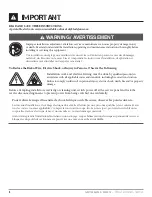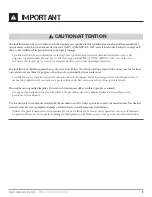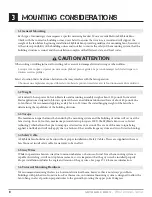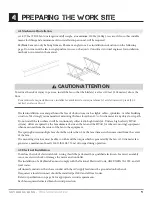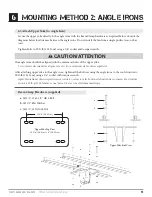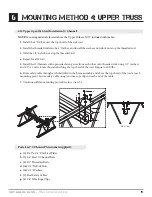
8
SKYBLADE FANS -
Where Form Follows Function
3
mOUNTING cONSIDERATIONS
3.1 General Mounting
Each type of mounting system requires a specific mounting bracket. Most are available from Skyblade Fans.
Check with the contractor, building owner, or architect to ensure the structure is sound and will support the
weight of the fan before beginning installation. Skyblade Fans provides guidelines for mounting fans; however, it
is the sole responsibility of the building owner and installer to ensure the safety of the mounting system, that the
building structure is sound, and the installation complies with all federal, state, and local codes.
3.2 Weight
A Standard 1-horsepower 16 foot 6-blade fan and mounting assembly weighs about 250 pounds. In inverted-
blade applications designed to blow air upward, there is an additional downward force of about 80 pounds due
to fan thrust. We recommend applying a safety factor of 2 times the stated hanging weight of the fan when
determining the capabilities of the building structure.
3.3 Torque
The maximum torque that must be handed by the mounting system and the building structure will occur at the
fans startup. For a 16 foot fan, maximum potential startup torque is 300 ft-lbs. Skyblade Fans use a soft-start
technology which allows the rpm to ramp up as desired over 60 seconds. The event of this max torque being
applied is unlikely and will only apply due to a failure of the variable frequency drive and its soft start technology.
3.4 Safety Cable
A Skyblade fan should never be run without proper installation of Safety Cables. These are supplied with every
fan. You must install safety cable for warranty to be in effect.
3.5 Guy Wires
While in operation a fan can sway due to minor imbalance or because of wind. Since the mounting system is
capable of swiveling, it will not stop fan movement, so it is important that the guy wires be installed properly.
Proper installation includes the angle and tension of the guy wires. See page 17-18 for more information.
3.6 Universal Mounting Hardware
We recommend mounting the fan to a horizontal structural beam, however, this is not always possible in
buildings with pitched roof construction. For this reason, our universal mounting system is designed to allow the
fan to hang in a level position perpendicular to the ground by rotating the upper yoke 90 degrees.
When cutting or drilling into a wall or ceiling, take care not to damage electrical wiring or other utilities.
Lorsque vous coupez ou percez un mur ou un plafond, prenez garde à ne pas endommager les fils électriques ou
d’autres services publics.
Select a location that is free from obstructions that may interfere with the fan’s operation.
Choisissez un emplacement qui est libre de tout obstacle pouvant interférer avec le fonctionnement du ventilateur.
CAUTION/ATTENTION
!


